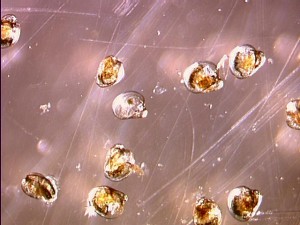Listen Up: Oysters May Use Sound to Select a Home
Oysters begin their lives as tiny drifters, but when they mature they settle on reefs. New research from North Carolina State University shows that the sounds of the reef may attract the young oysters, helping them locate their permanent home.

Larval oysters are planktonic, meaning that they cannot swim against or across currents. However, they do have the ability to move up and down within the column of water that they’re in. As they mature, they develop a muscular “foot” that they can use to sense the terrain along the ocean floor. When they find the right spot, they attach themselves and remain there throughout their lives.
Ashlee Lillis, an NC State Ph.D. candidate in marine science, wondered how the tiny oysters knew when to drop down and start looking for a home. Scientists know that larval oysters and other bivalves, like clams, respond to some chemical and physical signals within seawater, but Lillis wondered if the sound of the reef played a role.
“When you’re as small as these larvae, even if you’re only 10 or 15 feet up in a water column you wouldn’t have any real sense of where you were in terms of the seafloor beneath you,” Lillis says. “But an ocean reef has very loud, distinct sounds associated with it. They’re noisy enough to be heard by scuba divers and snorkelers. Even though oysters don’t have ears and hear like we do, they might be able to sense the vibration from the sounds of the reef.”
 Lillis and her advisor David Eggleston, professor of marine sciences, decided to test the hypothesis. With help from NC State geophysicist Del Bohnenstiehl, the team first made underwater sound recordings of oyster reefs and the open seafloor. Then they tested larval oysters in the wild and in the lab to determine if the settlement rates increased when they were exposed to reef sounds versus those from further out.
Lillis and her advisor David Eggleston, professor of marine sciences, decided to test the hypothesis. With help from NC State geophysicist Del Bohnenstiehl, the team first made underwater sound recordings of oyster reefs and the open seafloor. Then they tested larval oysters in the wild and in the lab to determine if the settlement rates increased when they were exposed to reef sounds versus those from further out.
The team found an increased settlement rate in both the lab and the wild when the larvae were exposed to reef sounds. Their results appear in PLOS ONE.
“The ocean has different soundscapes, just like on land,” Lillis says. “Living in a reef is like living in a busy urban area: there are a lot of residents, a lot of activity, and a lot of noise. By comparison, the seafloor is more like living in the quiet countryside.
Find out more about this project at the Soundscapes website: http://soundscapes.cmast.ncsu.edu
- Categories: